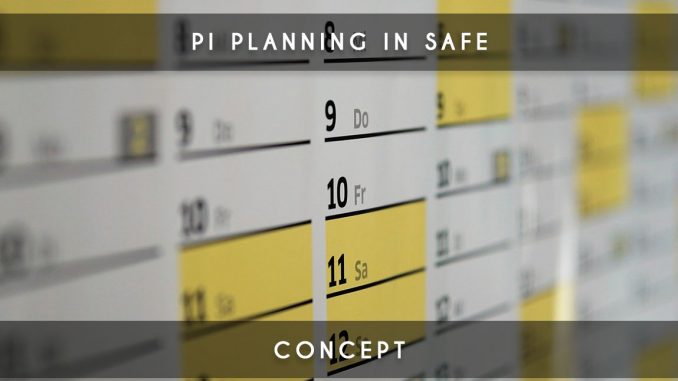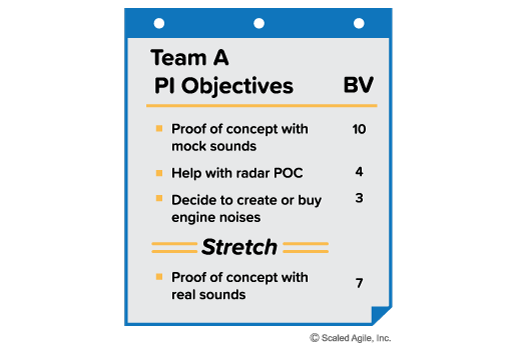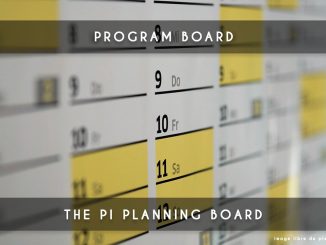
PI Planning is probably the most important SAFe ceremony. The SAFe is more and more popular so I thought that it’s interesting to purpose you an article to explain what the PI Planning globally.

What is the goal of PI Planning in SAFe?
The PI Planning (PI for Program Increment) is the ceremony that aligns all the teams of the Agile Release Train (Art) on vision and objectives for a duration of 8 weeks to 12 weeks (8 being recommended by the framework).
This ceremony will gather together more than 50 people in one room; if some teams are remote, so it is essential to have quality communication tools. Otherwise, you risk severely degrading the expected results.
At the first time, we have the impression that it’s too huge and unmanageable. In fact, this ceremony respect one agile manifesto principle:
The most efficient and effective method of conveying information to and within a development team is face-to-face conversation.
This agile manifesto principle describes the importance of pi planning in safe. Indeed, so that the PI Planning works well, it will be important for the Release Train Engineer (RTE) to prepare it in advance.
The benefits of PI Planning SAFe
On the official documentation of SAFe, the authors make a complete list of the benefits of PI Planning. So, it is very interesting to see them together:
- Create face-to-face communication between team members and stakeholders
- Build a real social network within the Art (Agile Release Train)
- Align developments to business objectives with the business context, vision, teams andPI Program objectives.
- Identify dependencies and foster collaborations between teams and Art.
- Provide the opportunity of “just the right amount” of architecture and advice on the Lean (UX) user experience
- Adapt demand to capacity, eliminating overworking (WIP)
- Fast decision making
Contents of the two days of PI Planning of SAFe (pi planning agenda)
Here is the schedule of two days of PI Planning to understand how the RTE will facilitate these two big days:

PI Planning process
Input Elements for PI Planning
To be able to do this event, there will be some expected essential to provide:
- business context
- roadmap and vision
- 10 main functionalities of program backlog
Objectives to obtain with PI Planning
We will wait at the output of this PI planning, two essential elements for the smooth progress of developments:
- the commitments of PI Planning
- an up-to-date program board

PI Planning schedule
Now we are going to see what the different steps of this PI Planning are.
First day of PI Planning
Business context
A senior executive or business owner describes the current state of the business ; he presents a perspective on how existing solutions meet the current needs of the customer.
Product / solution vision
The Product Management presents the current vision of the program (usually represented by the next 10 most important features to come) and highlights any changes compared to the previous PI Planning, as well as the next steps.
Architecture vision & development practices
System Architect presents the vision of architecture. In addition, a senior development manager can introduce the technical changes to implement to the next IP:
- test automation
- DevOps/craftsmanship
- Continuous integration, or even continuous deployment.
Planning context & lunch
The RTE presents the planning process and the expected results of this PI Planning.
Team breakouts #1
During the session, teams assess their capacity (velocity) for each iteration and identify the items in the backlog that they will likely need to complete the features. Each team creates its planning, visible to all, iteration by iteration.
Draft plan review
During the planning review, that is timeboxed, the teams present the main results of the planning, including draft objectives, potential risks and dependencies. Business Owners, Product Management, other teams and stakeholders review and provide input.
Management review & problem solving
It is likely that draft planning presents challenges such as scope, people and resources as well as dependencies. During the problem-solving meeting, management can negotiate changes of scope and solve other problems by accepting various planning adjustments. The RTE facilitates and ensures that stakeholders stay together as long as necessary to make thenecessary decisions to achieve achievable goals.
Second day of PI Planning
Then, here is the second day of this PI Planning:
Planning adjustments
The next day, the meeting begins with the managers who describe the changes to the scope and resources of the planning.
Team breakouts #2
The teams continue to plan with the agendas created the day before, making the appropriate adjustments. Indeed, they finalize their objectives for the PI (PI objectives) and the Business Owners assign a business value (BV) on these, as the picture below shown:

Use this template of PI objectives to simplify the used of these PI objectives. It help the team to well understand what the PI objectives are.
Let read our article to know more about the PI objectives : Pi objectives
Final plan review & lunch
During this session, all teams present their planning to the group. At the end of each explanation of one team, this team indicates its risks and obstacles; however, there is no attempt at resolution during this short period of time. If the proposed plan is acceptable to the clients, the team brings the PI program objectives sheet and risk sheet into the overall planning area so that all objectives and risks are shared to all participants ( and for better visibility).
Program risks
During planning, teams identified program risks and obstacles that could impact their ability to achieve their goals. These must be solved in a broader context or in front of the whole train. One by one, the risks are treated with honesty and transparency then classified in one of the following categories:
- resolved: the teams agree that the problem is not a concern anymore.
- assigned: someone in the train takes possession of the object because it can not be resolved at the meeting.
- accepted: some risks are just facts or potential problems that must be understood and accepted.
- mitigated: teams can identify a plan to reduce the impact of an item.
Confidence vote
Once the risks of the program have been determined, the teams vote (from 1 to 5) on their level of confidence in the possibility of achieving the expected objectives from the PI program.
Plan rework?
If necessary, the teams rework their planning until a high level of confidence can be achieved. This is an opportunity where alignment and commitment are valued more than the respect of an interval of time.
Planning retrospective & moving forward
Finally, the RTE makes a small retrospective of the PI planning. We could determine different things:
- what worked well
- are there things that did not work
- how improve the next PI planning.
Conclusion PI Planning
If this ceremony of SAFe seems terrifying at first, well prepared, it works rather well. Indeed, if the first iteration will be far to be perfect, all teams and RTE will benefit from each iteration to improve the format; So, don’t worry if the first time everything is not perfect.
So, do you want to try this practice?
Official blog of SAFe : Scaled Agile Framework




3 Trackbacks / Pingbacks